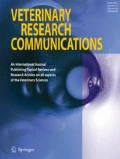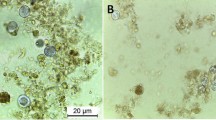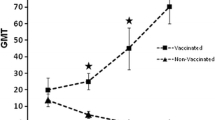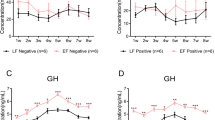Abstract
Florfenicol (FFC) as a chloramphenicol’s derivative is a special broad-spectrum antibiotic that was used in veterinary clinics. In the present study, we investigated the effect of different doses of FFC on the humoral immune response of broiler chickens to Newcastle disease virus (NDV) vaccine under the impact of E. coli infection. In addition, the expression of the interferon-inducible genes (IRF7, 2′-5′OAS and Mx1) were analyzed in the spleen tissue of these chickens using quantitative real-time PCR (qRT-PCR). The non-treated group with FFC and non-infected with E. coli had the highest immune responses against NDV compared with the FFC treated groups. In the case of E. coli infection, the group treated with FFC (30 mg/Kg BWt) showed lower NDV HI and IgG ELISA Ab levels compared to the group treated with FFC (60 mg/Kg BWt). A dose dependent up-regulation was observed in the level of the interferon-alpha pathway related genes (IRF7 and 2′-5′OAS) in the FFC treated groups compared to the non-treated group. At the slaughter time, the numbers of adipocyte in the bone marrow were significantly higher with moderate atrophy of the hematopoietic lineages in the FFC treated birds compared to the non-treated birds. These results indicated that this FFC dosage dependent increase in the humoral immune responses against NDV vaccine could be attributed to its efficient therapeutic effect on the E. coli infection. However, the increase in the FFC dosage can negatively but temporarily affect the chicken body weights. Additionally, it can exert up regulation effect on the chicken innate immune response with moderate hypoplasia of the bone marrow cells.





Similar content being viewed by others
References
Cao J, Li K, Lu X, Zhao Y (2004) Effects of florfenicol and chromium (III) on humoral immune response in chicks. Asian-Aust J Anim Sci 17:366–370
Chrzastek K, Madej JP, Mytnik E, Wieliczko A (2011) The influence of antibiotics on B-cell number, percentage, and distribution in the bursa of Fabricius of newly hatched chicks. Poult Sci 90(12):2723–2729
Dunn GP, Koebel CM, Schreiber RD (2006) Interferons, immunity and cancer immunoediting. Nature Rev Immunol 6(11):836–848
El Attar MA (1994) Effect of furaltadone and chloramphenicol on haemagglutination inhibition antibody to Newcastle disease virus. Iraqi J Vet Sci 7(2):77–84
Freedom of information summary (1996). Nuflor Injectable Solution for the treatment of bovine respiratory disease. NADA 141–063. Sponsor: Schering-Plough. June 1996
Frohli P, Graf C, Rhyner K (1984) Thiamphenicol induced bone marrow suppression as a therapy of myeloproliferative diseases. Blut 49(6):457–463
Garcia L, Bermudez V, Brett M, Peroza L, Landa J, Borregales F (2008) Quantitative analytical technique applied to histopathology of birds infected experimentally by the virus of chicken anemia virus. Diagn Pathol 3(Suppl 1):S21
Haller O, Stertz S, Kochs G (2007) The Mx GTPase family of interferon-induced antiviral proteins. Microbes Infect/Institut Pasteur 9(14–15):1636–1643
Hegazy AM, Abd-ElSamie LK, ELSayed EM (2010) The immunosuppressive effect of E. coli in chickens vaccinated with Infectious Bronchitis (IB) or Infectious Bursal Disease (IBD) vaccines. Journal of American Science 6
Khalifeh MS, Amawi MM, Abu-Basha EA, Yonis IB (2009) Assessment of humoral and cellular-mediated immune response in chickens treated with tilmicosin, florfenicol, or enrofloxacin at the time of Newcastle disease vaccination. Poult Sci 88(10):2118–2124
Khalil S, Hamed E, Hassanin O (2012) Residue withdrawal of florfenicol from the serum and edible tissues of broiler chickens. J Am Sci 8(12):514–524
LiRuChun (2008) Effects of Florfenicol on Humoral Immunity of ND in Chickens and Its Lesion of the Immune Organ. Master Thesis, Shandong Agricultural University
Lis M, Szczypka M, Suszko A, Switala M, Obminska-Mrukowicz B (2011) The effects of florfenicol on lymphocyte subsets and humoral immune response in mice. Pol J Vet Sci 14(2):191–198
Lunden T, Miettinen S, Lonnstrom LG, Lilius EM, Bylund G (1999) Effect of florfenicol on the immune response of rainbow trout (Oncorhynchus mykiss). Vet Immunol Immunopathol 67(4):317–325
Nakamura K, Imada Y, Maeda M (1986) Lymphocytic depletion of bursa of Fabricius and thymus in chickens inoculated with Escherichia coli. Vet Pathol 23(6):712–717
Ramadan H (2003) Effect of Ecoli Infection and its Treatment on the Immune Response for Newcastle Disease Vaccines in Chickens. Master, Zagazig University
Rue CA, Susta L, Cornax I, Brown CC, Kapczynski DR, Suarez DL, King DJ, Miller PJ, Afonso CL (2011) Virulent Newcastle disease virus elicits a strong innate immune response in chickens. J Gen Virol 92(Pt 4):931–939
Samuel CE (2001) Antiviral actions of interferons. Clin Microbiol Rev 14(4):778–809
Schumacher B, Bernasconi D, Schultz U, Staeheli P (1994) The chicken Mx promoter contains an ISRE motif and confers interferon inducibility to a reporter gene in chick and monkey cells. Virol 203(1):144–148
Senne DA (1989) Virus Propagation in Embryonating Eggs. In: Isolation and Identification of Avian Pathogens. 3rd edn. Kendal Hunt Publishing Company, Iowa, USA, pp 176–181
Skolimowski IM, Knight RC, Edwards DI (1983) Molecular basis of chloramphenicol and thiamphenicol toxicity to DNA in vitro. J Antimicrob Chemother 12(6):535–542
Syriopoulou VP, Harding AL, Goldmann DA, Smith AL (1981) In vitro antibacterial activity of fluorinated analogs of chloramphenicol and thiamphenicol. Antimicrob Agents Chemother 19(2):294–297
Tuttle AD, Papich MG, Wolfe BA (2006) Bone marrow hypoplasia secondary to florfenicol toxicity in a Thomson’s gazelle (Gazella thomsonii). J Vet Pharmacol Ther 29(4):317–319
Whitman K, Nair NM (2004) Bacteriology culture media. In: Whitman K, Nair NM (eds) Finfish and Shell Fish, Bacteriology Manual; Techniques and Procedures. Iowa State Press, AMES, pp 89–90
Yunis AA, Smith US, Restrepo A (1970) Reversible bone marrow suppression from chloramphenicol. A consequence of mitochondrial injury. Arch Intern Med 126(2):272–275
Acknowledgments
We are thankful to Prof Dr Adel Attia for kindly providing us with the E. coli strain, Dr Haitham Alyadin for the histopathological examination & imaging and Dr Fardous Abd-EL-Wahab for statistical analysis.
Author information
Authors and Affiliations
Corresponding author
Rights and permissions
About this article
Cite this article
Hassanin, O., Abdallah, F. & Awad, A. Effects of florfenicol on the immune responses and the interferon-inducible genes in broiler chickens under the impact of E. coli infection. Vet Res Commun 38, 51–58 (2014). https://doi.org/10.1007/s11259-013-9585-7
Accepted:
Published:
Issue Date:
DOI: https://doi.org/10.1007/s11259-013-9585-7




